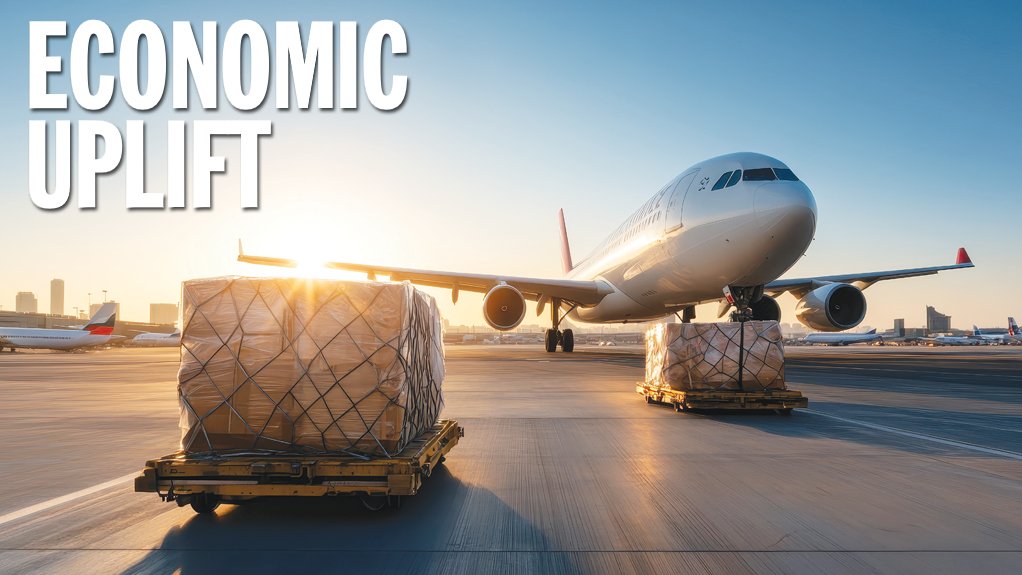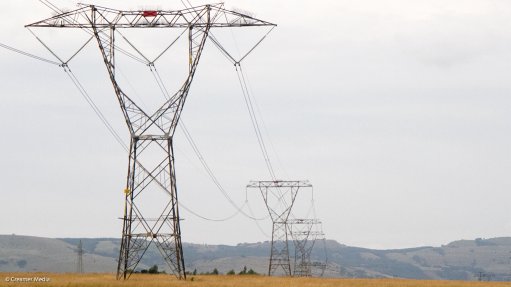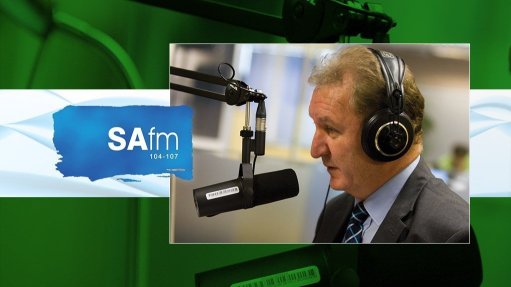Fit-for-purpose air cargo infrastructure seen as key growth driver
According to the International Air Transport Association (IATA), the global representative body for the airline (including air cargo) sector, while air cargo accounted for less than 1% of the volume of global trade, it accounted for 33% of the value. This worked out at $8.3-trillion a year of goods transported by air, or $22.7-billion a day, globally. IATA also reports that countries with 1% better air cargo connectivity gain 6% more trade.
Air cargo is air freight plus air mail. Worldwide, most air cargo is carried in the belly holds of airliners, and not in specialised freighter aircraft. This means that increasing the number of airliners flying into and out of a country automatically increases the county’s air cargo capacity.
South & Southern Africa
“Air cargo is crucial to the region’s economic growth, given that trade and industry rely on speedy and secure transportation of their goods and services,” highlights Airlines Association of Southern Africa CEO Aaron Munetsi, to Engineering News & Mining Weekly. “As economies fast-track into the digital world, the preferred mode of transport for the rapidly evolving e-commerce sector is air freight because it facilitates vital courier services. Air freight is the lifeline for key exports including perishables, pharmaceuticals, gemstones and other precious or time- sensitive commodities.”
“E-commerce growth in South Africa presents huge opportunities for air cargo,” affirmed technology investor and operator group Naspers South Africa CEO Phuthi Mahanyele-Dabengwa, in an address to the Western Cape Air Cargo Conference in March. “We must connect digital and physical supply chains to meet consumer expectations for fast and reliable delivery.”
Little wonder, then, that the South African government wants to facilitate the development of the country’s air cargo capacity. This was one of the themes of Transport Minister Barbara Creecy’s July 3 budget speech in Parliament. Unsurprisingly, she focused a lot of attention on the State-owned companies operating in the transport and logistics sector, including Airports Company South Africa (ACSA).
“To boost the contribution of aviation to tourism, economic development and job creation, we expect 42-million passengers and 1.2-million tons of air freight to move through the ACSA network of airports by the end of this political term [2029],” she said. “In order to meet our target of moving 42-million passengers per year and increasing air freight handling through the ACSA network of airports, the entity has allocated R21.7-billion for infrastructure development. This will improve facilities for passenger safety and comfort over the medium term and build a new freight terminal at OR Tambo International Airport.”
In the public sector, the perception of the importance of air cargo is not restricted to the national government. “If we want to attract investment, we need the right infrastructure to support air cargo growth,” pointed out Western Cape Agriculture, Economic Development and Tourism Minister Ivan Meyer, addressing the same conference as Mahanyele-Dabengwa.
South Africa’s Main Air Cargo Nodes
OR Tambo International Airport handles some 87% of the country’s international air freight. In March this year, the amount of outbound air freight through the airport was up 16%, year-on-year, while the quantity of inbound air freight had risen by 15%, over the same period. However, lack of infrastructure has indeed been an issue for the South African air cargo sector. The new cargo terminal at OR Tambo International Airport will be located next to a taxiway and is currently referred to as the Mid-Field Cargo Terminal.
“Our industry’s ability to increase cargo operations has been constrained by the lack of suitable on-airport infrastructure and a cumbersome customs clearance system,” points out Munetsi. “We urge ACSA to engage with all relevant industry players to ensure its planned new cargo hub at OR Tambo International Airport is a fit-for-purpose model of modern and efficient transport logistics. Similarly, to unleash South Africa’s dynamism and make its airports and harbours competitive hubs, then the SA Revenue Service must fast-track the digitalisation of its shipping and clearance administrative processes.”
OR Tambo is not, of course, the only international airport serving what is still the country’s economic heartland (Gauteng province accounts for 33% of the total South African economy). The other is South Africa’s only privately owned international airport, Lanseria, which also has a project to develop a modern air cargo “precinct”, in a ten-year phased project. The aim is to make Lanseria a regional logistics hub and construction of the first phase of the project is scheduled to start during the third quarter of this year.
“Beyond providing the airport with an additional revenue stream, this project will benefit businesses, particularly in the farming sector in this area and in neighbouring provinces,” explained Lanseria International Airport CEO Rampa Rammopo, in an address on June 25. “We hope this project will stimulate business activity, improve logistics and market access, and ultimately drive economic growth in the region.”
After Gauteng, the other two main economic centres in South Africa are Cape Town/Western Cape, and Durban/KwaZulu-Natal, responsible for 13.9% and 15.9% of the South African economy respectively in 2022. Cape Town’s and the Western Cape’s air cargo node is currently Cape Town International Airport, while that for Durban and KwaZulu-Natal is King Shaka International Airport/Dube Tradeport. But while the fluentcargo.com website ranks Cape Town International as 190th in the world, in terms of connectivity, King Shaka ranks lower, at 269th (OR Tambo International ranks 99th).
The Western Cape has a public-private partnership, Cape Town Air Access, to attract more and more airlines to institute services to and from Cape Town International Airport. This initiative is led by Wesgro, the province’s trade, tourism and investment promotion agency, but includes other national and provincial entities (such as ACSA) as well as the City of Cape Town and private sector entities.
Cape Town International Airport’s number of air passengers increased by 10% last year, compared with 2023. Air cargo that flowed through the airport last year was a record figure of 75 000 t, a 25% increase, year-on-year. Since 2018, air cargo passing through Cape Town International Airport has risen by 57%.
“We need to focus on what we can control – attracting investment, leveraging technology, and strengthening global partnerships,” highlighted Wesgro CEO Wrenelle Stander, addressing the Western Cape Air Cargo Conference in March. “This growth in connectivity means increased belly-freight cargo capacity and more opportunities to move goods by air.”
Despite an increasingly uncertain international trade environment, Cape Town Air Access intends to drive yet further air cargo growth for the city and the province. “We need to secure more flight routes and improve connectivity to drive economic growth,” affirmed Cape Town Economic Growth and Tourism Mayoral Committee Member Alderman James Vos, also at the Western Cape Air Cargo Conference.
“Expanding our air cargo capacity strengthens our logistics network, opens new trade opportunities, and helps position the Western Cape as a competitive player in the global market,” noted Meyer.
In KwaZulu-Natal, the key initiative is the Dube TradePort, which is a special economic zone, and an initiative of the KwaZulu-Natal provincial government. It is co-located with King Shaka International Airport.
A key element of the TradePort is the Dube Cargo Terminal. Opened in 2010, this is an up-to-date facility with staff certified by IATA. It has a capacity of 100 000 t, and has 900 m2 of refrigerated storage space, divided into three separate temperature zones. It is certified to handle dangerous goods. It operates on a 24/7 basis and has on site all the six required regulatory bodies for the approval of international and domestic air cargo. The apron (aircraft parking area) outside the terminal has the capacity to hold two wide-body aircraft at the same time.
During the 11 months from April 2022 to February 2023, the Dube Cargo terminal handled 13 146 t of freight. For 2023 as a whole, the terminal processed 14 424 t of cargo, including 900 t of perishable goods.
Restoring the Ecosystem
However, developing the country’s air cargo (and air passenger) potential depends upon a healthy wider aviation ecosystem. That is, on properly staffed, maintained and certified air traffic navigation and control systems, properly staffed regulatory bodies, assured fuel and other logistical supplies, and so on. And South Africa’s aviation ecosystem has not, in recent times, been as healthy as it should be. Creecy assured that the issues concerned were being addressed.
Thus, this year had seen the appointment of new members, with three-year terms, to both the Air Services Licensing Council (which regulated the domestic commercial aviation market) and the International Air Services Council (which regulated and controlled international air services to and from South Africa). These councils, among other duties, issued air service licences and were responsible for enforcement action should an operator not comply with the necessary laws and licences. Because the previous councils had lapsed, there was a backlog in the processing of air service licence applications and renewals. This backlog was to be audited, and the licence renewal process was to be reviewed, to cut red tape.
Projects to assure reliable jet fuel supplies for all airlines at South African airlines were being fast-tracked.
Last year, concerns emerged that the country’s air traffic control agency, Air Traffic and Navigation Services (ATNS), was not delivering the services it should. Creecy created a team of experts to investigate.
“In January, the team indicated that [ATNS] was facing acute shortages of critical staff that support safe navigation and operations; navigation and surveillance systems that have become unreliable due to poor maintenance and upkeep; flight procedures that had been allowed to lapse, despite the fact that they are critical for safe and efficient navigation; and systemic weaknesses in the safety management system,” she reported, in her budget speech. “Following the preliminary findings, four workstreams, led by ATNS executives and members of the Committee of Aviation Experts, focused on immediate interventions.”
Since February, 37 people have been recruited for key ATNS posts, including air traffic controllers, safety and investigation specialists, simulator programmers and engineering instructors. The agency’s internal training programme was being rebuilt, with 25 candidates, recruited both internally and externally, currently undergoing validation.
Urgently needed upgrades to ATNS’ communication, navigation and surveillance systems were progressing. Also progressing were the procurement processes to allow the stabilisation and upgrade of the country’s national air traffic management, arrivals management, and air traffic flow management, systems. Safety findings from audits carried out by both ATNS itself and the South African Civil Aviation Authority were being closed out. Of 18 posts in the Aviation Safety Office, ten were now filled.
“With respect to ensuring the availability of safe and compliant flight procedures across the country, more work still remains to be done,” she cautioned. “It is important to point out that a critical risk was averted with respect to the possible April 2025 suspension of procedures at OR Tambo International Airport, Cape Town International Airport, King Shaka International, Port Elizabeth, Lanseria and George Airports. Nevertheless, there are still too many instances, more than we are comfortable with, of operations that are dependent on alternative means of compliance or exemptions. Clearly this requires a degree of business unusual, and to this end the ATNS is putting in place a Project Office to drive the elimination of the backlog that has formed over the past few years.”
ATNS has itself publicly stated that it will need another 18 or so months to work through the complete backlog (totalling more than 300) of the flight procedures that were suspended last year. There are still suspended flight procedures at OR Tambo International, Cape Town International, and King Shaka International airports. Coupled with a shortage of air traffic controllers, these limit the number of aircraft able to enter, traverse or leave the airspace around these airports, and forces aircraft wanting to take off to queue on taxiways, while those seeking to land have to circle in holding patterns. All this burns fuel, drives up costs, and, for the moment, prevents the country expanding its air connectivity.
Article Enquiry
Email Article
Save Article
Feedback
To advertise email advertising@creamermedia.co.za or click here
Comments
Announcements
What's On
Subscribe to improve your user experience...
Option 1 (equivalent of R125 a month):
Receive a weekly copy of Creamer Media's Engineering News & Mining Weekly magazine
(print copy for those in South Africa and e-magazine for those outside of South Africa)
Receive daily email newsletters
Access to full search results
Access archive of magazine back copies
Access to Projects in Progress
Access to ONE Research Report of your choice in PDF format
Option 2 (equivalent of R375 a month):
All benefits from Option 1
PLUS
Access to Creamer Media's Research Channel Africa for ALL Research Reports, in PDF format, on various industrial and mining sectors
including Electricity; Water; Energy Transition; Hydrogen; Roads, Rail and Ports; Coal; Gold; Platinum; Battery Metals; etc.
Already a subscriber?
Forgotten your password?
Receive weekly copy of Creamer Media's Engineering News & Mining Weekly magazine (print copy for those in South Africa and e-magazine for those outside of South Africa)
➕
Recieve daily email newsletters
➕
Access to full search results
➕
Access archive of magazine back copies
➕
Access to Projects in Progress
➕
Access to ONE Research Report of your choice in PDF format
RESEARCH CHANNEL AFRICA
R4500 (equivalent of R375 a month)
SUBSCRIBEAll benefits from Option 1
➕
Access to Creamer Media's Research Channel Africa for ALL Research Reports on various industrial and mining sectors, in PDF format, including on:
Electricity
➕
Water
➕
Energy Transition
➕
Hydrogen
➕
Roads, Rail and Ports
➕
Coal
➕
Gold
➕
Platinum
➕
Battery Metals
➕
etc.
Receive all benefits from Option 1 or Option 2 delivered to numerous people at your company
➕
Multiple User names and Passwords for simultaneous log-ins
➕
Intranet integration access to all in your organisation



















